Giles Cory and the Salem Witch Craft Trials
The following is taken in part from:
The "Cory Family Newsletter", Volume 7, number 3, Sep 1992,
"The History of Salem", Volume III, pages 286-293,
"The Witchcraft Episode", pages 36-57,
"Salem In The Seventeenth Century", Chapter XXV,
"The Witches at Salem, 1692", by Dick Eastman on the Compuserve Genealogy Forum
"Witches and Wizards", by Robert Ellis Cahill former Essex County (Mass.) Sheriff and Keeper of the Salem Jail.
"The Salem Witchcraft Papers: Verbatim Transcripts of the Legal Documents of the Salem Witchcraft Outbreak of 169", Vols. I-III, transcribed in 1938 by Works Progress Administration under supervision of Archie N. Frost, Ed. by Paul Boyer and Stephen Nissenbaum, Da Capo Press, NY, 1977.
"Witchcraft at Salem", Chadwick Hansen, George Braziller, Inc., NY, 1969.
Chronology of Salem Witch Trials
L. David Roper Web page entitled Giles Corey of Salem, Massachusetts
 The opprobrious
epithet of witch-city which has tenaciously clung to Salem since 1692 is due to the fact that the witch trials and executions
took place in that town. The source of the excitement which resulted in the death for alleged witchcraft of twenty persons
within a year, lay in the a neighboring settlement, now the town of Danvers. At the time it was a parish of Salem Town, known
as Salem Village.
The opprobrious
epithet of witch-city which has tenaciously clung to Salem since 1692 is due to the fact that the witch trials and executions
took place in that town. The source of the excitement which resulted in the death for alleged witchcraft of twenty persons
within a year, lay in the a neighboring settlement, now the town of Danvers. At the time it was a parish of Salem Town, known
as Salem Village.
Difficulties and acrimonious disputes over church affairs had long prevailed in this community, which reached a climax when the Rev. Samuel Parris was finally chosen, in 1689, to take charge of the parish affairs. Parris appears to have entered the ministry somewhat late in life and had spent considerable time in the West Indies in business pursuits. He brought with him to Salem Village two native servants, or slaves of West Indian and African blood, known as Indian John and Tituba his wife---the immediate instigators of the events which were soon to follow.
Parris' difficulties began at once. He was at odds with his parishioners over salary, his parsonage, church rates, and in fact, over all matters pertaining to the conduct of his office. This led to a degree of bitterness in the community unusual even in those times of agitated public feeling. Apart from church affairs, there were also many disputes as to land rights, and personal animosities were widespread and rancorous. The setting was complete for an emotional outbreak.
In the long and bitter winter of 1691-92, some young women and girls at Salem Village had some meetings to learn palmistry and fortune-telling from Tituba. She was skilled in necromancy and various magic arts---perhaps African in origin, perhaps practiced by Indians---and found apt pupils in the children, who soon acquired proficiency in their use. Tituba claimed to know how to discover witches and the children may have read about evidences of witchcraft, but at any rate those impressionable young people soon began to act queerly and have spasms and fits.
These sessions apparently fired the imaginations of the girls, several of whom later started performing nightmarish fits and telling tales of witchcraft and of being possessed of evil spirits amongst them in Salem. On 20-Jan-1692, nine-year-old Elizabeth Parris and eleven-year-old Abigail Willams began to exhibit strange behavior, such as blasphemous screaming, convulsive seizures, trance-line states and mysterious spells. Within a short time, several other Salem Girls began to demonstrate similar behavior.
Doubtless at the outset, all this was innocent enough, until it attracted the attention of the elders who were at first mystified and then alarmed. Instead of keeping the children quietly at home and breaking up the meetings, their parents called in the local physician, Dr. Griggs. The doctor, who knew nothing about nerves and believed in witchcraft, finally decided, as was usual when the diagnosis was in doubt, that the actions of the girls in their fits and contortions could only be explained on the basis of witchcraft.
This group, know as the afflicted children, included:
-
Elizabeth Parris, nine years old, daughter of the Reverend Samuel Parris.
-
Abigail Williams, eleven years old, a niece of Mr. Parris and member of the household.
-
Ann Putnam, twelve years old, daughter of Sergeant Thomas Putnam, clerk of the parish.
-
Mercy Lewis, seventeen years old, who had been in the family of the Reverend
George Burroughts while he was at the Village, but now was a servant in Sergeant
Putnam's family. -
Mary Wolcott, seventeen years old, daughter of Captain Jonathan Wolcott, deacon
of the parish. -
Elizabeth Hubbard, seventeen years old, a niece of Mrs. Griggs, wife of the
Village Doctor. -
Elizabeth Booth, eighteen years old.
-
Susannah Sheldon, eighteen years old.
-
Mary Warren, twenty years old, servant in the family of John Proctor.
-
Sarah Churchill, twenty years old, servant in the family of George Jacobs, Sr.
These ten, with the occasional help of three married women, Mrs. Ann Putnam, mother of one of the girls, a Mrs. Pope, and Goody Bibber from Wenham, provided all the initial testimony on which nineteen persons were hanged, and well over a hundred more were cast into prison.
During the early spring of 1692 these children continued to have fits and convulsions at their meetings and attracted considerable attention to their antics and actions. They were all attributed by the people to witchcraft, and presently the children under this favorable notice began to extend their activities to the meeting-house on Sundays, crying out that they saw yellow birds sitting on the minister's hat, and other similar nonsense. It is not on record that Mr. Parris tried to suppress his niece and her friends and some of the parish grew annoyed and stayed at home.
In late February Mr. Parris sent for the neighboring ministers to come to his house to conduct solemn services to try to rescue the children from the clutches of the Evil One. Prayer services and community fasting were conducted by Reverend Samuel Parris in hopes of relieving the evil forces that plagued them. They corroborated the opinion of Dr. Griggs that the children's actions were the work of witches. In an effort to expose the "witches", Indian John baked a witch cake made with rye meal and the afflicted girl's urine. This counter-magic was meant to reveal the identities of the "witches" to the afflicted girls.
Pressure was put on the children to tell who afflicted them an they began to name various people: Goody Good, Goody Osburn, and the old Indian woman Tituba, and warrants were obtained for their arrest. They were arrested on February 28, 1692.
On March 1, 1692, John Hathorne and Jonathan Corwin, the magistrates, proceeded in state to the Village to hear the cases, escorted by the marshal of Essex and the constables, and stopped at Nathaniel Ingersoll's tavern, but the gathering was so great that they had to adjourn to the meeting-house.
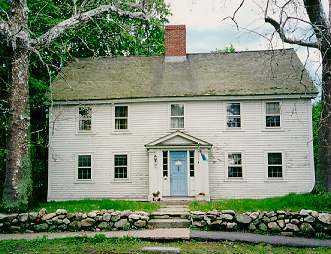
Nathaniel Ingersoll's Ordinary
(199 Hobart Street, located at the intersection of
Hobart and Centre Streets).
The three accused women were brought to Salem Town and examined by Magistrates Jonathan Corwin and John Hathorne. Corwin's home, the "Witch House", still stands at the corner of North and Essex Streets in Salem, providing guiding tours and tales of the first witchcraft trails.
Before an excited crowd, all of whom believed in the possible existence of witchcraft and in a personal devil, Sarah Good, Sarah Osburn, and Tituba were brought in. In spite of the "afflicted children" who charged them with hurting them, the first two steadfastly maintained that they had made no compact with the Devil, had not hurt the children, and were innocent; but the surprising thing is that Tituba admitted that she did serve the Devil; that her fellow prisoners were witches; also that they rode around on broomsticks accompanied by familiar spirits and did all sorts of injury. Tibuba confessed to seeing the devil who appeared to her "sometimes like a hog and sometimes like a great dog". What's more, Tituba testified that there was a conspiracy of witches at work in Salem. For five days the examination continued, and then the magistrates committed all three of the women to the jail in Boston.

Home of Witch Trials Judge Jonathan Corwin
Salem's only home with direct ties to the
Witch Trials of 1692.
The girls, under the lead of the elder girl, started to tell lies about different town folks which included Witchcraft accusations.
Over the next weeks, other townspeople came forward and testified that they, too, had been harmed by or had seen strange apparitions of some of the community members. As the witch hunt continued, accusations were made against many different people.
Frequently denounced were women whose behavior or economic circumstances were somehow disturbing to the social order and conventions of the time. Some of the accused had previous records of criminal activity, including witchcraft, but others were faithful churchgoers and people of high standing in the community.
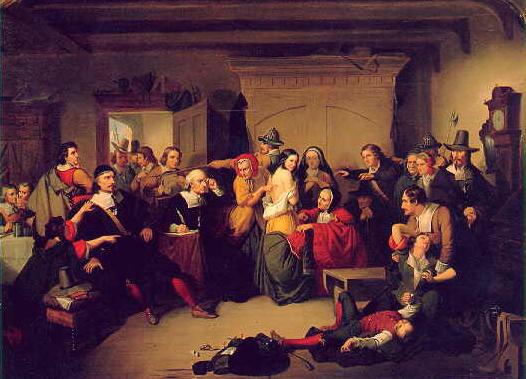
Examination of a Witch, by T.H. Matteson 1853.
Courtesy of the Peabody Essex Museum
Sarah Osborne and Sarah Dustin were both convicted of witchcraft and sentenced to be hung. Both died in the Salem Dungeon from exposure, ill treatment and lack of adequate food before the sentences could be carried out. It is also said that Sarah Osborne died two months later, May 10, in the Boston jail.
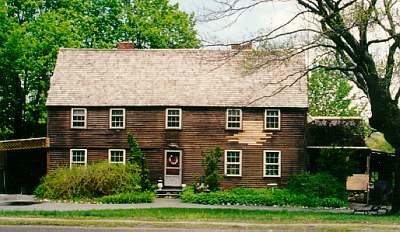
Sarah Osborne House
(272 Maple Street opposite Gorman Road)
Sarah Good was tried and convicted in June and hanged on the nineteenth of July, while Tituba lay in jail over a year and was finally sold as a slave for her board bill, as the Reverend Samuel Parris, her master, refused to redeem her.
John Willard early assisted in arresting the accused, but he had expressed sympathy with those under condemnation, and said, "Hang them, they they are all witches." It was latter reported that Mercy Lewis and Mary Walcott, while investigating an illness in the Wilkins family, that they "saw the apparitions of Sarah Buckley and John Willard upon the throat and breast of Henry Wilkins," and saw them press and choke him until he died.
A warrant for the arrest of Willard was issued May 10th on complaint of Thomas Fuller and others; but he could not be located until the eighteenth, when he was produced in court, having been found in Groton. He was given a preliminary examination at Beadle's Tavern, in Salem, at which the deposition of Mrs. Ann Putnam was probably put in evidence. The deposition concerned Willard, but finished with these words:
. . . Joseph Fuller's apparition also the same day came to me and told me that Goody Corey had killed him.
Martha Corey was charged on 19 March 1692:
"There being Complaint this day made before us, By Edward putnam and Henery Keney Yeoman both of Salem Village, Against Martha Cory the wife of Giles Cory of Salem farmes for suspition of haveing Comitted sundry acts of Witchcraft and thereby donne much hurt and injury unto the Bodys of Ann Putnam the wife of Thomas Putnam of Salem Village Yeoman And Anna Puttam the daugtter of s'd Thomas putnam and Marcy Lewis Single woman Liveing in s'd Putnams famyly; also abigail Williams one of mr parris his family and elizabeth Hubert Doctor Grigs his maid."
March 19th, a warrant was issued for the arrest of Martha Cory, wife of Giles Cory, and she was immediately taken into custody. She was examined before Justices Hathorne and Corwin. A woman of superior judgment and discretion, from the beginning she resolutely and persistently denounced the whole witchcraft proceedings. She endeavored to persuade her husband not to attend the hearings, nor to countenance the prosecutions in any manner. It is said that once she took the saddle off his horse to prevent him from going to an examination.
Martha Cory was generally disliked by her neighbors, something that may have been a contributing factor to her being accused. Years earlier she had given birth to an illegitimate child which apparently had not been well-received by the Puritans of Salem. When the girls first mentioned the name of Mrs. Cory, Edward Putnam and Ezekiel Cheever went to see her about the matter, March 12th. They saw Ann Putnam on the way, and asked her what clothes Mrs. Cory wore when her apparition appeared to her as Ann had said. Ann said that she was so blinded she could not see. Arriving at the Cory house, Mrs. Cory said to them, "I know what you have come for. You are come to talk with me about being a witch, but I am none. I cannot help people talking about me." She inquired whether the afflicted had attempted to describe her clothes. This last statement was deemed to be supernatural, and was used in her trial later on. She told them that she did not think there were any witches.
Martha Cory, Giles third wife and Rebecca Nurse were arrested March 19th. Probably the arrest of Rebecca Nurse was instigated by the enmity of the Putnams, who, mother and daughter, were among the chief accusers though the following months. Overwhelmed by the accusations against two such respected persons as Goodwives Cory and Nurse and inflamed by a sermon preached by Rev. Deodat Lawson, which was interrupted by the antics of several of the prosecuted children, popular feeling reached a degree of panic, which precluded any possible control of the rising excitement.
On March 28 Elizabeth Proctor was denounced as a witch and on April 3, Sarah Cloyce, Rebecca Nurse's sister, was accused of witchcraft.
On April 11, the colony as a whole took cognizance of the trouble, and the Deputy Governor Thomas Danforth and six magistrates, James Russell, John Hathorne, Isaac Addington, Major Samuel Appleton, Captain Samuel Sewall, and Jonathan Corwin appeared in Salem to hold court.
Elizabeth Proctor and Sarah Cloyce were examined before Hathorne, Corwin, Deputy Governor Thomas Danforth, and Captain Samuel Sewall. During this examination, John Proctor was also accused and imprisoned.
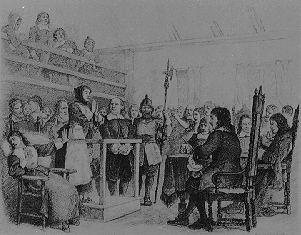
In the examination of Martha Cory, the following colloquies occurred:---
Mr. Hathorne.
You are now in the hands of authority. Tell me, now why you hurt these persons?Martha Cory.
I do not.Hathorne.
Who doth?Cory.
Pray give me leave to go to prayer. (This request was made at sundry times.)Hathorne.
We do not send for you to go to prayer, but tell me why hurt these.Cory.
I am an innocent person. I never had to do with witchcraft since I was born. I am a gospel woman.Hathorne.
How could you tell, then, that the child was bid to observe what clothes you wore when some one came to speak with you?
(Cheever interrupted her and bid her not begin with a lie, and so Edward Putnam declared the matter.)
Who told you that?
Cory.
He said the child said.Cheever.
You speak falsely. (Then Edward Putnam read again.)Hathorne.
Why did you ask if the child asked what clothes you wore?Cory.
My husband told me the others told.Hathorne.
Goodman Cory, did you tell her? (The old man denied that he told her so.)Hathorne.
Did you say your husband told you so?Cory --- no answer.
Hathorne.
You dare thus lie in all this assembly. You are now before authority. I expect the truth. You promised it. Speak now and tell who told you what clothes.Cory.
Nobody.
Once the children cried, "A man is whispering in her ear.
Hathorne.
What did he say to you?Cory.
We must not believe all that these distracted children say.
In his report of this trial, Mr. Parris said: When she bit her lip, several of the afflicted were bitten; when her hands were at liberty, they were pinched; etc., etc.
Hathorne.
Do you not see how these afflicted do charge youCory.
We must not beleive distracted personsHathorne.
Who do you improve to hurt themCory.
I improved noneHathorne.
Did not you say our eyes were blinded you would open themCory.
Yes to accuse the innocent"
...
Hathorne.
You charge these children with distraction: it is a note of distraction when persons vary in a minute, but these fix upon you, this is not the manner of distraction-Cory.
When all are against me w't can I help itHathorne.
Now tell me the truth will you, why did you say that the Magistrates & Ministers eyes are blinded you would open them
She laught & denyed it.
Hathorne.
What do you say to all these thing that are apparentCory.
If you will all go hang me how can I help it.Hathorne.
Were you to serve the Devil ten years tell how many
She laught
Mrs. Cory was badgered by Hathorne, badgered by Corwin, badgered by Rev. Mr. Noyes, badgered by the Marshall and others.
Her own husband testified against her:
"The evidence of Giles Choree testifieth & saith that Last satturday in the Evening. sitting by the fire my wife asked me to go to bed. I told I would go to prayr. & when I went to prayer I could nott utter my desires w'th any sense, not open my mouth to speake My wife did perceive itt & came towards. me & said she was coming to me. After this in alittle space I did according to my measure attend the duty. Sometime last weake I fetcht an ox well out the woods, about noone, & he laying down in the yard I went to raise him to yoake him butt he could not rise butt dragd his hinder parts as if he had been hiptshott, butt after did rise.
I had a Catt somtimes last weeke strangly taken on the suddain & did make me think she would have died presently, #[butt] my wife bid me knock her in the head. butt I did not. & since she is well. Another time going to duties I was interrupted for aspace, butt affterward I was helpt according to my poore measure.
My wife hath ben wont to sitt up after I went to bed, & I have perceived her to kneel down to the harth. as if she were at prayr, but heard nothing.
March: 24'th 1691/2"
During her examination, Mrs. Pope threw a shoe at her and it struck on her head.
After the same absurd scenes and alleged evidence, Sarah Cloyse and John Proctor and his wife Elizabeth, with Rebecca Nurse, Martha Cory, and Dorcas Good, the little five-year-old daughter of Sarah, who had been held in Salem, were sent to Boston Jail.
Rebecca Nurse was first granted a reprieve by the jury in her witchcraft case. Judge John Hathorne refused to accept the verdict and he convinced the jury to change their verdict. Judge Hathorne is now known as Salem's "witch hanging judge" and also was the great-great-grandfather of Nathaniel Hawthorne, author of the "House of Seven Gables." John Hathorne is buried in the Charter Street "Old Burying Point."
This examination was most unfortunate, as it immediately gave the matter importance throughout the colony, whereas it had been a local affair up to that time.
As if there was not excitement enough, the Reverend Deodate Lawson was invited back to preach a powerful lecture-day sermon on the text, "And the Lord said unto Satan, the Lord rebuke thee, O Satan! even the Lord that has chosen Jerusalem rebuke thee; is not this a brand plucked out of the fire?" As may be supposed, he handled the Devil in a way to let no one doubt his reality, or the utter damnation that would follow any association with him. This did not tend to allay the excitement.
The accusers were not satiated yet. Warrants and commitments now followed in rapid secession. The next victim was Giles Cory, eighty years of age (Really 71 years old.). He was infatuated by the storm of witchcraft, and attended the hearings. At last the girls did not think that he was as strong as he ought to be in some of his evidence in a case, and cried out upon him, declaring that he afflicted them with fits and pinches.
On 18 April 1692 Exekiell Chevers and John Putnam, Jr. made a complaint against Giles Corey for witchcraft done on Ann Putnam, Marcy Lewis, Abig'l Williams, Mary Walcot and Eliz. Hubert.
There being Complaint this day made (Before us) by Ezekiell Chevers and John Putnam Jun'r both of Salem Village Yeomen: in Behalfe of theire Majesties, for themselfes and also for theire Neighbours Against Giles Cory, and Mary Waren both of Salem farmes And Abrigail Hobbs the daughter of Wm hobs of the Towne of Topsfield and Bridgett Bushop the wife of Edw'd Bishop of Salem Sawyerfor high Suspition of Sundry acts of Witchcraft donne or Committed by them, upon the Bodys of : Ann Putnam. Marcy Lewis, and Abig'l Williams and Mary Walcot and Eliz. Hubert-of Salem village -whereby great hurt and damage hath benne donne to the Bodys of Said persons above named.therefore craved Justice-
You are therefore in their Majest's names hereby required to apprehend and bring before us Giles Cory & Mary Waren of Salem farmes, and Abigail Hobs the daughter of Wm Hobs of the Towne of Topsfeild and Bridget Bushop the wife of Edward Bushop of Salem To Morrow about Eight of the Clock in the forenoone, at the house of Lt. Nathaniell Ingersalls in the Salem Village in order to theire Examination Relateing to the premises aboves'd and here of you are not to faile
Dated Salem April 18'th 1692.
Another line of damning testimony was that Giles Corey participated in "the sacriment" at a gathering of witches. John DeRich testified that.
"gils Cory...told me that he wanted som platers for he was gowen to afeast...he took the platers and cared them a way being gown a bout half a oure with them...". A deposition by Elizabeth Booth stated "there appeared to us a grate number of wicthes as neare as we could tell about fifty thirteen of which we knew: who did Receive the sacriment in our right amongst whicth we saw Giles Cory who brought to us bread and wine urging us to pertake thereof: but because we Refused he did most greviously afflect and torment us: and we beleve in our hearts that Giles Cory is a wizzard..."
On April 18th, Giles Cory and Mary Warren of the Village, Abigail Hobbs of Topsfield, and Bridget Bishop of Salem were arrested. On April 19th, they were examined. Only Abigail Hobbs confessed.

Bridget Bishop House
(Plate 19; 238 Conant Street).
The court ordered Cory's hands to be tied, and they asked him if it were not enough to "act witchcraft at other times, but must you do it now in face of authority?" He replied, "I am a poor creature and cannot help it." Again, a magistrate exclaimed, "Why do you tell such wicked lies against witnesses?" One of his hands was loosed and the girls were afflicted. He held his head on on side, and the heads of the afflicted were held on one side. He drew in his cheeks, and the cheeks of the afflicted were sucked in.
This was a preliminary examination. He was never formally tried, as he would not plead. He was committed to jail.
Two days later, April 22th, nine more, Nehemiah Abbott, William and Deliverance Hobbs, Edward and Sarah Bishop, Mary Easty, Mary Black, Sarah Wildes, and Mary English were examined before Hathorne and Corwin. Only Nehemiah was cleared of charges.
May 2, Sarah Morey, Lydia Dustin, Susannah Martin, and Dorcas Hoar were examined by Hathorne and Corwin.
Several other arrests followed.

William Stoughton, Judge
Reverend George Burroughs had earlier been pastor of the Salem Village church but had left for a parish in Wells, Maine after arguments with Ann Putnam, the mother of the 12-year-old of the same name. In 1692, daughter Ann Putnam testified that Rev. Burroughs had appeared before her in an apparition one night asking her to sign the Devil's books. Two women also appeared in this apparition, Ann Putnam reported that they were the Rev. Burroughs' first and second wives. These wives "told" Ann Putnam that Rev. Burroughs had murdered both of them. Based upon this apparition, on May 4, Rev. George Burroughs was arrested in Wells, Maine and brought back to Salem. Burroughs was examined by Hathorne, Corwin, Sewall, and William Stoughton on May 9. One of the afflicted girls, Sarah Churchill, was also examined.
May 10th, George Jacobs, Sr. and his granddaughter Margaret were examined before Hathorne and Corwin. Margaret confessed and testified that her grandfather and George Burroughs were both witches.

Trial of George Jacobs, 1692 by T.H. Matteson.
The original of this oil painting hangs in the Peabody Essex Museum.
It was painted in 1855 and is by no means historically accurate but is very dramatic
On May 14th, several more warrants, including one for Elizabeth Cory of Charlestown, were issued. This continued through the first week of June.
Also on May 14th, Increase Mather returned from England, bringing with him a new charter and the new governor, Sir William Phips.
Now the trouble took a new turn. A woman in Andover was sick of some fever not understood, so her husband posted down to Salem Village to get a couple of the "afflicted children" to come up and say who was bewitching her. They came and trouble spread like wildfire. Dudley Bradstreet, son of the old Governor, was the magistrate, and at first went along with the excitement, but, when some fifty persons had been arrested, he declined to go further. He was, of course, suspected, so he and his wife and brother fled and escaped. A dog supposed to have been bewitched by the brother was executed!
May 18th, Mary Easty was released from prison. Yet, due to the outcries and protests of her accusers, she was arrested a second time.
May 27th, a new court of primarily Boston men was appointed by the new Governor, Sir William Phips. The special Court of Oyer and Terminer comprised of seven judges to try the witchcraft cases. Appointed were Lieutenant Governor William Stoughon, Nathaniel Saltonstall, Bartholomew Gedney, Peter Sergeant, Samuel Sewall, Wait Still Winthrop, John Richards, John Hathorne, and Jonathan Corwin.
These magistrates based their judgments and evaluations on various kinds of intangible evidence, including direct confessions, supernatural attributes (such as "witchmarks", and reactions of the afflicted girls. Spectral evidence, based on the asumption that the Devil could assume the "specter" of an innocent person, was relied upon despite its controversial nature.
Martha Carrier, John Alden, Wilmott Redd, Elizabeth Howe, and Phillip English were examined before Hathorne, Corwin, and Gedney on May 31.
John Alden, son of the couple John Alden and Priscilla Mullins, was a resident of Boston when accused by the young girls of Salem of witchcraft. Alden was arrested and brought to Salem to face the girls. When Alden approached them in court, the girls who had accused him all fell to the floor in a faint. Alden then turned to Judge Hathorne and said, "What's the reason you don't fall when I look at you?" Hathorne had no answer, but he imprisoned Alden anyway. Three months later John Alden managed to escape from jail and he was never apprehended. On June 2nd, the initial session of the Court of Oyer and Terminer was held. The court held its meetings in the town-house and began its sessions the first week in June. They tried and sentenced Bridget Bishop.
Soon after Bridget Bishop's trail, Nathaniel Saltonstall resigned from the court, dissatisfied with its proceedings.
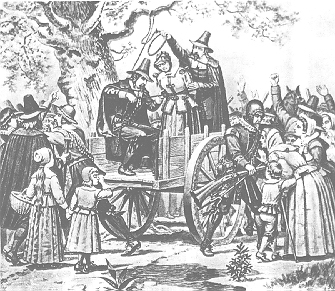
The June 10, 1692 hanging of Bridget Bishop
Bridget Bishop was the first to be hung for witchcraft. There is still debate today as to whether or not she should be included in the list of Salem witches of 1692. Bridget Bishop had been tried for witchcraft in 1679 and acquitted. She was a twice-widowed tavern owner, owning "an ordinary" on the road between Salem and Beverly. She served a new and powerful drink called "rum" to many of the sailors who frequented her place. The sailors also played an evil new game called "shuffleboard that upset many of the neighbors. Bridget wore bright clothes, a major offense in the eyes of the Puritans of Salem. Bridget apparently was condemned more for her lifestyle and for the veiled accusations of prostitution that cannot be proven or disproved today. Bridget Bishop was hanged June 10 in Salem, the first official execution of the Salem witch trails.
Following her death, accusations of witchcraft escalated, but the trials were not unopposed. Several townspeople signed petitions on behalf of accused people they believed to be innocent.
During this time, two dogs were also hung by the neck at Gallows Hill because one of the girls said they had appeared to her as the Devil's disciples and gave her the evil eye. On June 29-30, they tried and sentenced five more, Rebecca Nurse, Susannah Martin, Sarah Wildes, Sarah Good, and Elizabeth Howe.
The following dialogue is based on the examination of Sarah Good by Judges Hathorne and Corwim, from "The Salem Witchcraft Papers", Book II, page 355.
What evil spirit have you familiarity with?
None.
Have you made no contract with the devil?
No.
Why do you hurt these children?
I do not hurt them. I scorn it.
Who do you imploy then to do it?
I imploy no body.
What creature do you imploy then?
No creature. I am falsely accused.
In mid-July an effort to expose witches afflicting his life, Joseph Ballard of nearby Andover enlisted the aid of the accusing girls of Salem. This action marked the beginning of the Andover witch hunt.
July 19, Rebecca Nurse (age 70), Susannah Martin, Elizabeth Howe, Sarah Good, and Sarah Wildes were executed.

August 2-6, the court condemned six more, George Jacobs, Sr., Martha Carrier, George Burroughs, John and Elizabeth Proctor, and John Willard.
All were executed on the nineteenth except Elizabeth Proctor by hanging on Gallows Hill.
The September sitting of the court began the sixth and ended on the seventeenth. The trial of Mrs. Cory occurred September 10th, and she was convicted and sentenced on the same day. Mary Easty, Alice Parker, Ann Pudeator, Dorcas Hoar, and Mary Bradbury were also tried and condemned.
Mary Bradbury of Salisbury was found guilty of witchcraft, but managed to escape the jail before execution. She apparently had assistance in this from her friends and relatives, she was never re-captured. By Sep 17, Margaret Scott, Wilmott Redd, Samuel Wardwell, Mary Parker, Abigail Faulkner, Rebecca Eames, Mary Lacy and her mother Ann Foster, and Abigail Hobbs were tried and condemned.
Mary Lacy of Andover was accused of witchcraft and admitted to it. She said "me and Martha Carrier did both ride on a stick or pole when we went to witch meetings at Salem Village." Ironically, those who confessed to being witches were not executed, but many of those who denied witchcraft were hung. Mary Lacy was allowed to go free after her "confession" but she had damned Martha Carrier in the process. Martha was hung a few weeks later. Mary Lacy's mother, Ann Foster, died in a Salem Dungeon due to ill treatment from Sheriff George Corwin.
At the September sitting of the court, Giles was arraigned. The following deposition is by one of the girls who accused Giles of witchcraft. The document is from the records of the Court of Oyer and Terminer, September 9, 1692, property of the Supreme Judicial Court, Division of Archives and Records Preservation, on deposit at the Essex Institute, Salem, Essex Co, MA.
Mercy Lewis v. Giles Cory
The Deposition of Mercy lewes agged about 19 years woh testifieth and saith that on the 14th April 1692 I saw the Apperishtion of Giles Cory com and aflect me urging me to writ in his book and so he contineued most dreadfullly to hurt me by times beating me & almost braking my back tell the day of his examination being the 19th April and then allso during the time of his examination he did affect and tortor me most greviously: and also several times sence urging me vehemently to writ in his book and I veryly believe in my heart that Giles Cory is a dreadfull wizzard for sence he had ben in prison he or his apperance has com and most greviously tormented me.
Mercy Lewis affirmed to the jury of Inquest. that the above written evidence: is the truth upon the oath: she has formerly taken in court of Oyer & Terminer: Septr 9: 1692
Similar depositions were given by Mercy Lewis, Sarah Bibber, Mary Warren, Elizabeth Woodwell, Mary Walcott, Elizabeth Hubbard and Benjamin Gould. Susannah Sheldon's testified that
"the Spectre of Giles Corey Murdered his first wife & would have murdered this to if she had not been a Witch..."
Thomas Putnam wrote a letter to Judge Samuel Sewall in which he brought up an old case against Giles Corey:
"...my daughter Ann...there appeared unto her (she said) a man in a Winding Sheet; who told her that Giles Cory had Murdered him, by Pressing him to Death with his Feet; but that the Devil there appeared unto him, and Covenented with him, and promised him, He should not be Hanged....For all people now Remember very well, (and the Records of the Court also mention it,) That about Seventeen Years ago, Giles Cory kept a man in his House, that was almost a Natural Fool: which Man Dy'd suddenly. A Jury was Impannel'd upon him, among whom was Dr. Zorobbabel Endicot; who found the man bruised to Death, and having clodders of Blood about his Heart. The Jury, whereof several are yet alive, brought in the man Murdered; but as if some Enchantment had hindred the Prosecution of the Matter, the Court Proceeded not against Giles Cory, tho' it cost him a great deal of Money to get off."
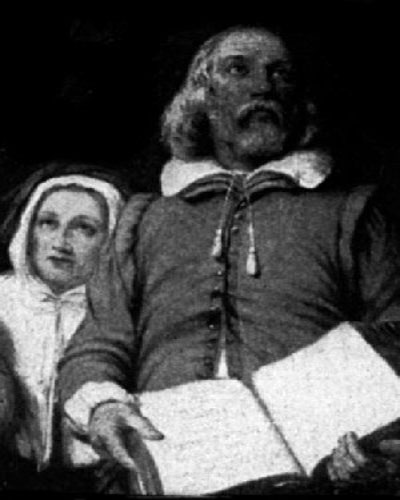
He was asked to plead, that is, to appeal to his country, to a jury trial, which at that time all persons charged with crime must do before a jury could try them. He "stood mute," and would not plead. The old English Law of "Peine forte et dure" furnished but one remedy for this situation. The prisoner should:
be remanded to the prison from whence he came and put into a low dark chamber, and there be laid on his back on the bare floor, naked, unless when decency forbids; that there be placed upon his body as great a weight as he could bear, and more, that he hath no sustenance, save only on the first day, three morsels of the worst bread, and the second day three droughts of standing water, that should be alternately his daily diet till he died, or, till he answered.
Giles Cory suffered this rather than to appeal to his countrymen, as he was fully convinced that he must die anyway, and he was obstinate enough to cheat the gallows. So to avoid giving the prosecution any advantage, he would answer nothing, whereupon he was sentenced to be pressed to death. Hence, refusing to put himself on trial (no trial actually took place). Giles reportedly was a stubborn, fiery man who realized that he would not get a fair trial. By not pleading one way or the other, English law dictated that a person could not be tried, but the penalty for standing mute was "slow crushing under weights" until a plea was forthcoming or the person died. His death was the result of his obstinacy and firmness with scarcely a parallel---certainly not in American annals.
On September 17, the Sheriff led Giles to a pit in the open field beside the jail and before the Court and witnesses in accordance with an English procedure of the "Peine forte et dure". They striped Giles of his clothing, laid him on the ground in the pit, placed boards on his chest, six men lifted heavy stones, placing them one by one, on his stomach and chest. Giles Corey did not cry out, which perplexed Sheriff Corwin whose duty it was to squeeze a confession from the old man.
After two days, Giles was asked three times to plead innocent or guilty to witchcraft, to which he would say more weight. "Do you confess?" the Sheriff cried over and over. More and more rocks were piled onto him, and the Sheriff, from time to time, would stand on the boulders staring down at Corey's bulging eyes. Robert Calef, who was a witness along with other townsfolk, later said, "In the pressing, Giles Corey's tongue was pressed out of his mouth; the Sheriff, with his cane, forced it in again."
Three mouthfuls of bread and water were fed to the old man during his many hours of pain. Finally, Giles Corey cried out at Sheriff Corwin, "Damn you. I curse you and Salem!" Giles Corey died a few seconds later.
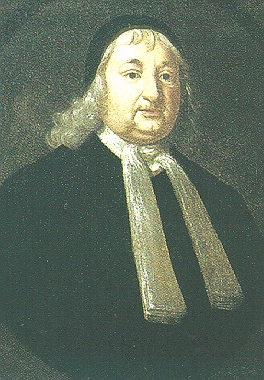
Samuel Sewall, trial judge
Sewell's diary states, under date of Monday, September 19, 1692:
About noon at Salem, Giles Cory was pressed to death for standing mute; much pains was used with him two days, one after another, by the court and Captain Gardner of Nantucket who had been of his acquaintance, but all in vain.
In the whole history of English law very few people had had the fortitude to "stand mute" and endure a penalty expressly designed to discourage such obstinacy. This is the only instance in the history of New England where this law was applied. The execution of Giles Cory by this process had nothing to do with witchcraft. If he had refused to plead to a charge of burglary, the penalty would have been the same.
Except in the cases of treason, conviction could not be obtained on a prisoner who stood mute. With out conviction his property could not be confiscated by the crown or provincial government. Many of Corey's friends believed he remained silent in court because his conviction for the came would have meant the forfeiture of his estate. Otherwise, the Sheriff would confiscate it. But the fact is that he had executed a deed before this to his sons-in-law. Civil and criminal charges had followed him most of his life.
The day following Cory's death, Thomas Putnam sent to Judge Sewall the following communication:
Last night my daughter Ann was grievously tormented by witches, threatening that she should be pressed to death before Giles Corey, but through the goodness of a gracious God, she had, at last, a little respite. Whereupon there appeared unto her (she said) a man in a winding sheet who told her that Giles Corey had murdered by pressing him to death with his feet; but that the devil then appeared unto him and covenanted with him and promised him that he should not be hanged. The apparition said, God hardened his heart that he should not hearken to the advice of the court, and so die an easy death; because, as it said, it must be done to him as he had done to me. The apparition also said that Giles Corey was carried to the court for this and that the jury had found the murder; and that her father knew the man and the thing was done before she was born.
On Sep 21, Dorcas Hoar was the first of those pleading innocent to confess. Her execution was delayed.
For the forth and last time, the procession left Salem jail for the place of execution of those persons condemned for witchcraft, on Thursday, September 22d. There were eight victims this time. Samuel Wardwell of Andover was the only man to thus suffer, the women were Mrs. Martha Cory, wife of Giles Cory, Alice Parker, wife of John Parker, and Ann Pudeator, widow of Jacob Pudeator, all of Salem, Mary (Towne) Easty, sister of Rebecca Nurse and wife of Isaac Easty of Topsfield, Margaret Scott, widow of Benjamin Scott of Rowley, aged about seventy-five, Wilmot Reed ("Mammy Red"), wife of Samuel Reed, of Marblehead, and widow Mary Parker of Andover. Upon the ladder, Mrs. Cory, protesting her innocence, concluded her life with an earnest prayer. After the sheriff had done his part in the affair, Rev. Nicholas Noyes, of Salem, turned toward the suspended bodies of the victims, and said: "What a sad thing it is to see eight firebrands of hell hanging there."
After 20 people had been executed in the Salem witch hunt, Thomas Brattle wrote a letter on October 8th, criticizing the witchcraft trials. This letter had great impact on Governor Philps, who ordered that reliance on spectral and intangible evidence no longer be allowed in trials.
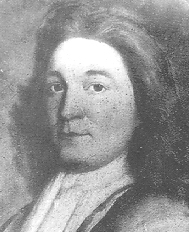
Sir Willaim Phips, Governor
On Oct 29, Governor Philps dissolved the Court of Oyer and Terminer.
The General Court of the colony created the Superior Court on Nov 25 to try the remaining witchcraft cases which took place in May 1693. This time no one was convicted.
In the spring of 1693, Sir William Phips, Governor of Massachusetts, liberated 168 people in Salem's Witch Dungeon who awaiting the hangman's noose. Several of these people died shortly thereafter from their neglect and abuse while in the dungeon. By 1710, the General Court had begun to "reverse some of the convictions, judgments and attainders and declare them null and void," and in the next year or two some compensation, if inadequate, had been paid to the families of some of the sufferers. The First Church in Salem erased from their records and blotted out the excommunication of Rebecca Nurse and Giles Cory.
The Reverend Samuel Parris, after a long acrimonious struggle with the men whose wives, mothers, and friends he had helped to drag to the gallows, was driven from the Village in 1697, and, after unimportant service in the frontier towns, died in Sudbury in 1720. His wife died and was buried in Danvers before he left that parish.
One of the young girls, Ann Putnam confessed her fraud 14 years later at the age of 26. She had her minister read the confession at Sunday service "It was a great delusion of Satan that deceived me in that sad time whereby I justly fear I have been instrumental to bring upon myself and this land the guilt of innocent blood." The following is a list of those hanged at Gallows Hill, Salem, Massachusetts for witchcraft:
| Name | Village or Town | Date |
| Bridget Bishop | Salem | 10-Jun-1692 |
| Sarah Good | Salem Village (Danvers) | 19-Jul-1692 |
| Susanna Martin | Amesbury | 19-Jul-1692 |
| Elizabeth Howe | Ipswich | 19-Jul-1692 |
| Rebecca Nurse (or Nourse) | Salem Village (Danvers) | 19-Jul-1692 |
| Sarah Wildes | Topsfield | 19-Jul-1692 |
| George Jacobs | Salem Village (Danvers) | 19-Aug-1692 |
| Martha Carrier | Andover | 19-Aug-1692 |
| Reverend George Burroughs | Wells, Maine | 19-Aug-1692 |
| John Proctor | Salem Village (Peabody) | 19-Aug-1692 |
| John Willard | Salem Village (Danvers) | 19-Aug-1692 |
| Martha Corey | Salem Village (Peabody) | 22-Sep-1692 |
| Mary Easty | Topsfield | 22-Sep-1692 |
| Alice Parker | Salem | 22-Sep-1692 |
| Mary Parker | Andover | 22-Sep-1692 |
| Ann Prudeater | Salem | 22-Sep-1692 |
| Wilmot Reed | Marblehead | 22-Sep-1692 |
| Margaret Scott | Rowley | 22-Sep-1692 |
| Samuel Wardwell | Andover | 22-Sep-1692 |
Accused of Witchcraft, died in jail:
-
Sarah Osburn, May 10, 1692
-
Roger Toothaker, June 16, 1692
-
unnamed infant of Sarah Good, prior to July 19, 1692
-
Ann Foster, Dec. 3, 1692
-
Lydia Dastin, March 10,1693
While the term "Salem Witches" is common nowadays, it ignores the fact that most of the accused were not from Salem. The jail and site of executions were in Salem, but the accused were mostly from other towns and villages in the area. Only 10 of the 134 who were accused and were held in Salem's Jail were from Salem Towne. The complete count was:
| 1 Amesbury 38 Andover 2 Boxford 1 Boston 6 Billerica 6 Beverly 3 Charlestown 1 Chelmsford |
3 Gloucester 3 Haverhill 1 Great Island 2 Marblehead 7 Lynn 1 Malden 4 Reading 1 Rowley |
1 Romney Marsh (today called Revere) 1 Salisbury 10 Salem 30 Salem Village (today this is part of Danvers and of Peabody) 7 Topsfield & Ipswich 1 Wells, Maine 3 Woburn |
In addition to the 134 above, another 34 were accused and in various jails awaiting trial when Governor Phips released all the prisoners.
The only person who seemed to profit from the witchcraft hysteria was Sheriff George Corwin who confiscated property and pocketed fees collected from the accused and their relatives.
Giles Corey's son-in-law, John Moulton, husband of Elizabeth Corey, presented a document to the General Court on 13 September 1710:
"...in the yere 1692 some time in march our honerd father and mother Giles Corey & Martha his wife ware acused for soposed wich Craft and imprisoned and ware Removed from on prison to another as from Salem to ipswich & from ipswitch to boston and from boston to Salem againe and soe remained in Close imprisonment about four months...our father was put to soe Cruell and painfull a death as being prest to death our mother was put to death also though in another way."
It is remarkable that the original 552 documents recording court testimony during the witchcraft trial have been preserved and are still stored by the Peabody Essex Museum.
There is a popular theory today that moldy rye was the real cause of the Salem hysteria. An article in "Science Magazine," April 2, 1976, by Linda, Caporael, a University of California graduate student, reveals that the physical afflictions of the accusing girls might have been caused by "Convulsive Ergotism", a disorder resulting from the ingestion of contaminated rye grain. "Rye, which grows in low, wet ground, yields ergot," wrote Miss Caporael. Rye was known to be a staple in the diets of the Salem Puritans. Rye was a common ingredient of bread and was eaten as a cereal. Judge Sewall's diary for the summer of 1692 states that the rye harvest was during a time that was "rainy and warm, hot and stormy." Ergot (claviceps purpura) is spread by a fungus that causes symptoms of hallucination, violent fits, choking, pinching, itching, a crawling sensation in the skin and muscular contractions. Linda Caporael adds that "females and children are more likely to get ergot poisoning than the males."

